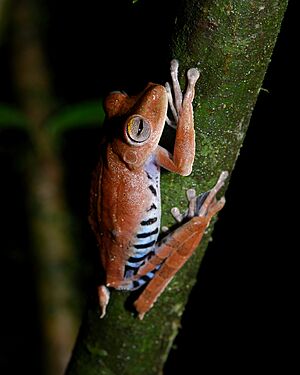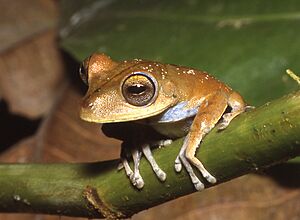Troschel's tree frog facts for kids
Quick facts for kids Troschel's tree frog |
|
|---|---|
 |
|
| In Yasuni National Park | |
| Conservation status | |
| Scientific classification | |
| Synonyms | |
|
Troschel's treefrog is a cool frog also known as the blue-flanked treefrog or the convict treefrog. It belongs to the Hylidae family, which are often called "treefrogs." You can find this frog in many parts of the Amazon Basin, including Suriname.
Contents
About Troschel's Treefrog
What Does It Look Like?
Adult male Troschel's treefrogs are about 28 to 43 millimeters long. That's about the size of a large paperclip! Female frogs are a bit bigger, measuring 46 to 56 millimeters.
Their fingers have a little bit of webbing at the bottom. Their toes, however, are fully webbed, which helps them climb and swim. Male frogs also have special spines near their thumbs.
The color of their back can be light brown, reddish brown, or just brown. They often have a dark brown line down the middle of their back. Some frogs might even have faint brown stripes across their body. Their legs usually have light brown stripes too.
You might see tiny white and black dots on their back. Sometimes they have larger dark brown spots instead. A cool feature is their sides, which can be white, light blue, or even bright blue! These blue sides have dark brown vertical stripes. Their belly is a creamy white, and their lower belly is yellowish white.
Where Does It Live?
Troschel's treefrog lives in tropical rainforests. They are found at elevations up to 1,000 meters above sea level. However, they usually live below 400 meters. These frogs are arboreal, meaning they love to live in trees.
During the rainy season, you can spot adult frogs sitting on small branches. They like to be above slow-moving streams. This is where they lay their eggs.
Life Cycle and Reproduction
Troschel's treefrogs lay their eggs in water. After the eggs hatch, the young frogs, called larvae or tadpoles, develop in the water. This is a common way for many frogs to start their lives.
Protecting Troschel's Treefrog
Like many animals, Troschel's treefrog faces some challenges. Their habitat is sometimes lost because of things like cutting down forests for farms or logging. Forest fires can also harm their homes.
However, this frog is quite common in many areas where it lives. It is also found in protected areas, like national parks. Because of this, scientists believe that Troschel's treefrog is not currently threatened with extinction.



